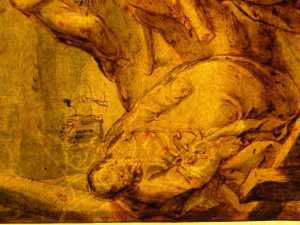Specificaties
| Titel | Christus op de Olijfberg |
|---|---|
| Materiaal en techniek | Pen in bruine inkt, bruin en blauwgrijs gewassen, wit gehoogd, doorgegriffeld, kaderlijnen met de pen in bruine inkt |
| Objectsoort |
Tekening
> Tweedimensionaal object
> Kunstvoorwerp
|
| Locatie | Dit object is in het depot |
| Afmetingen |
Hoogte 140 mm Breedte 104 mm |
|---|---|
| Makers |
Tekenaar:
Karel van Mander
|
| Inventarisnummer | MB 1723 (PK) |
| Credits | Aankoop 1871 |
| Collectie | Tekeningen & Prenten |
| Verwervingsdatum | 1871 |
| Vervaardigingsdatum | in 1596 |
| Signatuur | 'KvM in[venit]' gemonogrammeerd (linksonder, in pen in bruine inkt) |
| Watermerk | Crowned crest, probably Coat of arms of Burgundy and Austria with Golden Fleece beneath (fragment: the third top part with crown, also found in inv. MB 1723 and 1726, the lower third part with the Golden Fleece is in inv. MB 1721 and 1722), in the centre of the left margin (vV, 5?P, quarto, very fine), very similar to Heawood 481 (Schieland 1602 and in Jodocus Hondius, Theatrum Artis Scribendi, Amsterdam 1594), similar to Churchill 266, but without housemark in the lower section of the shield (no place, 1623)(for a discussion of the paper, see under inv. MB 1721). This type of watermark (large fragment, only the bottom part with Golden Fleece missing) is also found in a drawing by Karel van Mander in The Metropolitan Museum of Art, New York, inv. no. 2009.334. The full watermark is present in an anonymous drawing, formerly attributed to Cornelis van Haarlem, also in the Museum Boijmans (inv. no. MB 1705, a cropped plano sheet). [AE] Five of the drawings for the Passion series (inv. nos. MB 1721, 1722, 1723, 1726 and MB 1728) contain fragments of the same type of watermark, situated in the middle of the left or right edge. From the fact that watermarks are generally found in the centre of one of the two halves of a production sheet or plano (c. 220 x 300 mm), we can infer that the thirteen small pieces of paper of this series were cut from four full production sheets. Each full sheet was folded twice and subsequently cut in four parts. Then the pieces of paper were cropped to almost exactly the same dimensions, thus losing a small margin. The watermark can be reconstructed by piecing together the top third part (a crown) found in inv. nos. MB 1723, 1726 and 1728 with the lower third part (bottom of the shield and the sign of the Order of the Golden Fleece beneath) found in the present sheet and in MB 1722. Because of the trimming of the sheets the central (approximately one third) section of the coat of arms is now missing. The lower section, however, bears the heraldic characteristics for a positive identification with the coat of arms of Burgundy and Austria. The same type of watermark (a large fragment, only the bottom part with Golden Fleece missing) is also found in a drawing by Karel van Mander, The Servants of Absalom killing Amnon, in New York. It is also found in the contemporary book by Jodocus Hondius, Theatrum Artis Scribendi, published in Amsterdam in 1594, just two years before the Passion series (Heawood 481, also found in Schieland documents, dated 1602). The other sheets, or rather pieces of paper, do not have a fragment of a watermark, which can be explained by the fact that half of the four pieces cut from a full sheet do not have one, and in some cases the view is obscured by the drawing preventing detection of a watermark fragment if present. All pieces of paper have the same waterline-chainline pattern. [Albert Elen] |
| Conditie | foxing in de rechter helft |
| Inscripties | ‘4’ (verso, rechtsonder, in potlood), ‘4’ (verso, rechtsonder, in pen in bruine inkt) |
| Merkteken | Museum Boymans Rotterdam (L.288) |
| Tentoonstellingen | Rotterdam 2008 (coll 1); Parijs/Rotterdam 2014, nr. 57.4; Washington 2017, nr. # |
| Externe tentoonstellingen |
Bosch to Bloemaert. Early Netherlandish Drawings from the Museum Boijmans Van Beuningen (2014) Bosch to Bloemaert. Early Netherlandish Drawings (2017) Roep om rechtvaardigheid (2018) |
| Onderzoek |
Toon onderzoek Nederlandse tekeningen uit de vijftiende en zestiende eeuw |
| Literatuur | cat. 1901, p. 47, nr. 521; Valentiner 1930, p. 87, nr. Z.6; Stampfle 1991, p. 14, onder nr. 21, Miedema 1995, p. 119, nr. D9; New Hollstein 1999a, appendix 2, nr. 10, en onder nr. 58; New Hollstein 2000a, dl. 1, p. 81, onder nr. 38; Collection Catalogue 2012 (online) |
| Materiaal | |
| Object | |
| Techniek |
Grijs gewassen
> Wassen
> Gewassen
> Tekentechniek
> Techniek
> Materiaal en techniek
Gehoogd
> Schildertechniek
> Techniek
> Materiaal en techniek
Doorgriffelen
> Doorgegriffeld
> Tekentechniek
> Techniek
> Materiaal en techniek
Blauw gewassen
> Wassen
> Gewassen
> Tekentechniek
> Techniek
> Materiaal en techniek
Bruin gewassen
> Wassen
> Gewassen
> Tekentechniek
> Techniek
> Materiaal en techniek
|
| Geografische herkomst | Noordelijke Nederlanden > Nederlanden > West-Europa > Europa |


























